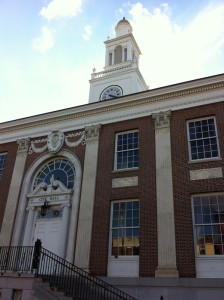3.7 percent of voters in Burlington’s last big election not on rolls

ELECTIONS MESS: Officials at Burlington’s City Hall are under under pressure to clean up elections after intense scrutiny from citizens and Monday’s halt of early voting.
By Bruce Parker | Vermont Watchdog
Unpublished data from Burlington’s last big election reveals a significant number of votes were cast by individuals whose names were not on the statewide checklist.
In the 2012 presidential election, 17,383 votes were cast in Burlington, according to city-published data. According to data not published by the city, but made available to Vermont Watchdog, 639 of those votes, or 3.7 percent, came from election day walk-in voters whose names were not on the voter rolls and whose registration status was unknown.
As previously reported by Watchdog, votes by individuals whose names don’t appear on the checklist count whether or not the voters can be verified as having registered with the state.
The unpublished data sheds light on elections in Burlington after citizen poll watchers exposed a need for greater scrutiny in the Queen City, and after city officials on Monday halted early voting when Republican candidates for Justice of the Peace were found missing from the ballot. Reprinted ballots will cost the city $10,000.
In big elections in Burlington, hundreds of people absent from voter rolls show up to vote. Instead of being turned away or given provisional ballots, the individuals fill out voter affirmation forms, get added to the statewide checklist and vote on the spot. Critics say the process is rife with abuse and amounts to same-day registration.
When Watchdog contacted the clerk/treasurer’s office to find out how many individuals voted in recent elections despite not appearing on the statewide checklist, Scott Schrader, Burlington’s elections chief, said affirmation forms from the 2012 presidential election were discarded. Forms from this year’s Town Meeting Day went missing with a clerk who no longer works for the city.
Watchdog obtained the unpublished data from printed checklists updated by poll workers and maintained by the Board for Registration of Voters.
In the 2012 general election, voters whose names were not on the checklist, but were handwritten-in and permitted to vote in Burlington, were as follows: Wards One and Two, 181; Ward Three, 114; Ward Four, 50; Ward Five, 128; Ward Six, 112; and Ward Seven, 54.
Burlington isn’t the only city that experiences unusually high numbers of unverified voters in big elections. Montpelier also saw a spike in 2012.
John Odum, city clerk for Montpelier, said his office kept a record of voter affirmation forms filled out during the 2012 general election. Of 4,558 votes cast in Montpelier, 98 votes, or 2.2 percent, came from individuals whose names were not on the statewide checklist.
“(The numbers) were quite high for the last general. It was a little jaw-dropping, actually,” Odum told Vermont Watchdog. “You find a lot more of them in the general (election). That’s when the parties and candidates make the big push to go out and get people registered.”
According to Odum, Vermont allows such voting because delays exist in the voter registration process. He confirmed that individuals whose names don’t appear on the statewide checklist cast standard ballots, not provisional ballots, after signing an affirmation form.
“The affirmation is an affidavit you’re signing under penalty of perjury. You’re basically saying, ‘I did my part in good faith; in good faith, I registered or thought I was registering … and yet I did not show up on your checklist.’”
Will Senning, elections director at the Vermont Secretary of State’s Office, said not only do such individuals vote on election day, but they also become registered voters right there at the polling place.
“By statute, the Board of Civil Authority is directed to add to the checklist, at the polling place, the names of persons who sign the affirmation form and are otherwise qualified to be on the checklist … There is no further verification required,” he wrote in an email.
When asked what would happen if such voters didn’t, in fact, register through the DMV, a clerk’s office or a third-party group, Senning replied:
“Because the affirmation form is a legal document signed by the voter under pains of perjury, and because statute directs that persons who sign that form be added to the checklist at the polling place, their vote is counted the same as all other registered voters.”
Officials in Burlington and Montpelier said they weren’t worried about fraud since voters face the threat of perjury.
When asked if the state ever prosecuted anyone for falsifying voter affirmation forms, Odum replied, “I don’t know. It’s an interesting question.”
When the question was put to Schrader, he said, “I have no idea.”
Nevertheless, both affirmed the public needn’t worry about the surge of people showing up to vote in big elections despite not being on the voter rolls.
“When they get that affidavit, that is the process by which they affirmatively state, ‘I did do my job as a citizen, I did register to vote, and I’m not on your list. And I should have the right to vote anyway.’ And then you given them a ballot,” Odum said.
Contact Bruce Parker at bparker@watchdog.org







